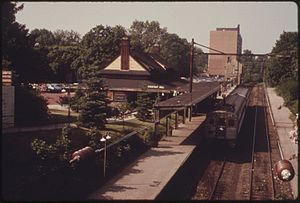Westmoreland (PRR station)
| Chestnut Hill West Line | |||
|---|---|---|---|

A Penn Central Silverliner at Chestnut Hill West station in May 1974.
|
|||
| Overview | |||
| Type | Commuter rail | ||
| System | SEPTA Regional Rail | ||
| Status | Operating | ||
| Termini |
Chestnut Hill West Temple University |
||
| Daily ridership | 5,651 (2016) | ||
| Website | septa.org | ||
| Operation | |||
| Operator(s) | SEPTA | ||
| Technical | |||
| Track gauge | 4 ft 8 1⁄2 in (1,435 mm) standard gauge | ||
| Electrification | Catenary | ||
| Operating speed |
50 mph (Chestnut Hill West to North Philadelphia) 70 mph (North Philadelphia to Zoo Interlocking) |
||
|
|||
50 mph (Chestnut Hill West to North Philadelphia)
The Chestnut Hill West Line is a commuter rail line in the SEPTA Regional Rail network. It connects Northwest Philadelphia, including the eponymous neighborhood of Chestnut Hill, as well as West Mount Airy and Germantown, to Center City.
The Chestnut Hill West Line branches off from Amtrak's Northeast Corridor at North Philadelphia station and runs entirely within the City of Philadelphia. Its terminal is named Chestnut Hill West to distinguish it from the end of the Chestnut Hill East Line (a competing line of the Reading Company until 1976). Some stations are less than half a mile apart, a characteristic more commonly seen in an urban rapid transit system rather than a commuter rail line. The line runs roughly parallel to the Chestnut Hill East, and the two terminals are rather close.
The line was originally opened June 11, 1884 by the Philadelphia, Germantown and Chestnut Hill Railroad, and was operated by the Pennsylvania Railroad until 1968. Electrified service began on March 30, 1918. The Penn Central operated it until 1976, turning operations over to Conrail until 1983, when SEPTA took over.
...
Wikipedia
